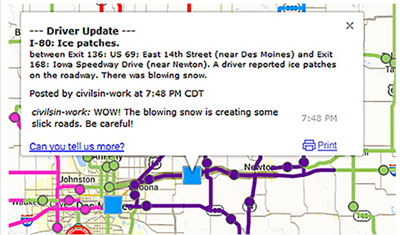By Shannon Fiecke, Research Services

Iowa launched Citizen Reporting system in November. Here is an example of a citizen report. |
MnDOT is testing a crowd-sourcing application that will allow motorists to update winter weather road conditions on the state's 511 system.
The Regional Transportation Management Center is planning a soft launch of Citizen Reporting in April, initially inviting MnDOT employees to post their experiences on routes they travel. By next winter, the RTMC hopes to invite the public to do the same.
“We suspect that citizen reporters will be similar in ethic to the kinds of people who volunteer to be weather spotters,” said Mary Meinert, transportation program specialist who assists Kelly Kennedy Braunig, the state's 511 System Coordinator, with day-to-day operations of 511.
Currently, MnDOT maintenance crews report road conditions, but outstate Minnesota lacks 24/7 coverage and its reports can become quickly outdated, especially on highways that aren’t plowed as frequently or lack traffic cameras, Braunig said.
Citizen reporting, especially on weekends, will help keep that information fresh.
“We try to explain on the website that we only update from 3 to 6 a.m., 3 to 6 p.m. Monday through Friday and as road conditions change, but we still get many emails requesting more frequent road condition information,” Braunig said.
Even a recent comment on MnDOT's Facebook pointed out the limitations in one area of the state: “Updates [only] come during government work hours.”
Growing service
It’s actually a welcome sign that the public wants more from 511.
Seven years ago, when Braunig applied for her job, not many people used 511. In fact, at the time, she wasn't even aware of the service, which provides information to travelers on weather-related road conditions, construction and congestion.
Today, 511’s online program and mobile app are accessed by more than 5,000 people per day during the winter (and about half as many during the summer). Data comes from MnDOT’s construction and maintenance offices as well as state trooper data and incident response. This real-time information is available for all of Minnesota.
In the Twin Cities metro area, more than 700 traffic cameras allow MnDOT and State Patrol dispatchers to check the condition of 170 miles of highways and monitor traffic incidents at any time. Rochester, Duluth, Mankato and Owatonna also have cameras for incident management and traffic monitoring.
The 511 system's greatest challenge is in Greater Minnesota, where road condition information is used daily by schools, ambulance personnel and truckers, as well as the traveling public, but information isn't updated frequently outside of business hours. Citizen reporting will be a beneficial resource.
Other states
Other northern states face similar challenges as Minnesota, but have been able to improve the timeliness of road condition data with assistance from truckers and other motorists.
In Wyoming, more than 400 citizen reporters (primarily truckers) call in road conditions to the Transportation Management Center. In Idaho, citizen reporters directly report the information into the 511 system. Minnesota will be the fifth state to adopt citizen reporting, following Iowa, which launched its service in November 2014.
Like Iowa, Minnesota’s citizen reporting initially will focus on winter roads.
To participate, people will need to take an online training module and then register their common routes, perhaps the highways they take to work or their way to the cabin on the weekends. These contributions will be marked as a citizen report on the website.
“Minnesota truck drivers are loyal users of the 511 system and we suspect they will also make some of our best reporters,” Meinert said.
Minnesota is part of a 13-state consortium that shares a 511 service technology provider. States with citizen reporting recently shared their experiences in a Peer Exchange sponsored by North/West Passage, a transportation pooled fund that is developing ways to share 511 data across state lines.
“With citizen reporting we hope to give people a voice and a chance to participate,” Braunig said.
For more information on the 511 Citizen Reporting program or if you would like to participate, contact Braunig at kelly.braunig@state.mn.us or Meinert at mary.meinert@state.mn.us.
|



